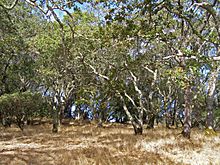California oak woodland facts for kids

California oak woodland is a plant community found throughout the California chaparral and woodlands ecoregion of California in the United States and northwestern Baja California in Mexico. Oak woodland is widespread at lower elevations in coastal California; in interior valleys of the Coast Ranges, Transverse Ranges and Peninsular Ranges; and in a ring around the California Central Valley grasslands. The dominant trees are oaks, interspersed with other broadleaf and coniferous trees, with an understory of grasses, herbs, geophytes, and California native plants.
Oak savannas occur where the oaks are more widely spaced due a combination of lack of available moisture, and low-intensity frequent fires.
The oak woodlands of Southern California and coastal Northern California are dominated by coast live oak (Quercus agrifolia), but also include valley oak (Q. lobata), California black oak (Q. kelloggii), canyon live oak (Q. chrysolepis), and other California oaks. The foothill oak woodlands around the Central Valley are dominated by blue oak (Q. douglasii) and gray pine (Pinus sabiniana).
California oak-woodland communities
- Oregon oak woodland is found in Northern California's Klamath-Siskiyou, Northern Coast Ranges, and southern Cascade Range. These woodlands are composed primarily of Oregon oak (Q. garryana), interior live oak (Q. wislizeni), and coast live oak, together with California black oak, canyon live oak, blue oak, Pacific madrone (Arbutus menziesii), California bay (Umbellularia californica), incense cedar (Calocedrus decurrens), coast Douglas fir (Pseudotsuga menziesiivar. menziesii), Coulter Pine and ponderosa Pine (Pinus ponderosa).
- Blue oak woodland is found in the inner coast ranges and the Sierra Nevada foothills, surrounding the Central Valley. It forms "one of the largest ecosystems in California". Primary species are blue oak (Q. douglasii) and interior live oak (or on west facing slopes facing the exterior ranges, particularly in Contra Costa and Alameda counties, coast live oak takes interior live oak's place), together with valley oak, canyon live oak, California scrub oak (Q. berberidifolia), gray pine, California buckeye (Aesculus californica), and western redbud (Cercis occidentalis).
- Coast live oak woodland is widespread in northern and southern California, and is dominated by coast live oak (Q. agrifolia), together with California buckeye, Pacific madrone, California bay, and California walnut (Juglans californica).
- Interior live oak woodland is found in north and south mountain ranges of California. It is dominant by interior live oaks(Q. wislizeni), blue oaks, foothill pine and shrubs in common with blue oak woodland.
- Valley oak woodland is found in the interior valleys of northern, central and southern California, and is dominated by valley oak (Q. lobata) and coast live oak, together with gray pine and Coulter pine (Pinus coulteri).
- Island oak woodland is found on the California Channel Islands, and is made up primarily of island oak (Q. tomentella) and coast live oak, together with canyon live oak, MacDonald scrub oak (Q. berberidifolia) hybridized with valley or other oaks), Catalina ironwood (Lyonothamnus floribundus), and bishop pine (Pinus muricata).
- Engelmann oak woodland is found in a few locations in the northern Peninsular Ranges of Southern California, including the Santa Rosa Plateau and San Gabriel Mountains foothills. It consists mostly of Engelmann oak (Q. engelmannii) together with coast live oak.
Status and future of California oak woodlands
Blue oak woodlands cover about 2,939,000 acres (11,890 km2) of the state, and of this area about 79%, or 2,322,000 acres (9,400 km2), shows no evidence of past cutting of trees. Recent research by the University of Arkansas Tree-Ring Laboratory has studied several unlogged stands of blue oak woodlands, and suggests that the state may harbor over 500,000 acres (2,000 km2) of such old growth forests. This would make California's oak woodlands some of the most extensive old growth forests left in the state. However, most oaks of full tree size are more than one hundred years old, and few saplings are ever produced, because cattle often tear the plants to pieces.
The Oaks 2040 survey estimates that 750,000 acres (3,000 km2) of California oak woodlands are seriously threatened by 2040 as a burgeoning state population makes ever more use of the wildland. This comprehensive survey includes oak woodland maps and inventory data for the ten oak types found in California. By evaluating this new information against current State of California economic growth projections, the location and extent of oak woodlands most at risk of development are identified.
Examples of occurrence
The headwaters area of Yulupa Creek in Annadel State Park is cited as one of the best examples of California oak woodlands. Much of this woodland is a relatively pristine ecosystem with considerable biodiversity. An unusual characteristic of this Annadel forest is the high content of undisturbed prehistoric bunch grass understory, testifying to the absence of historic grazing or other agriculture.

